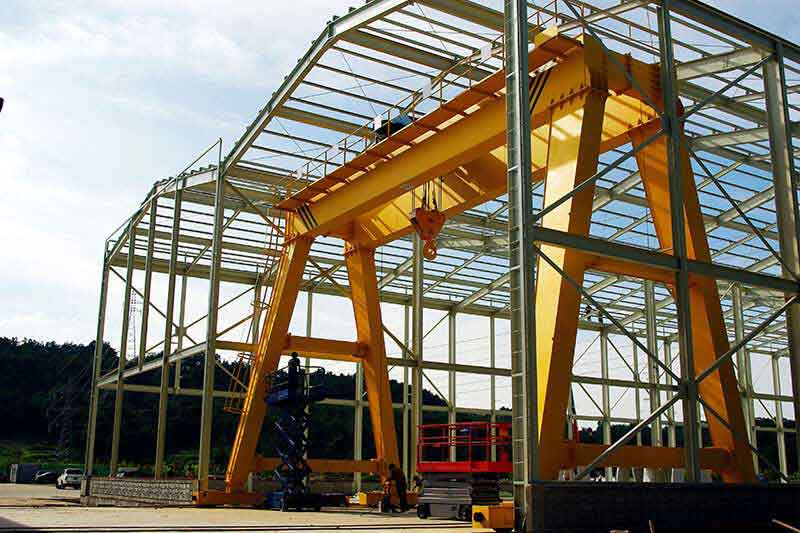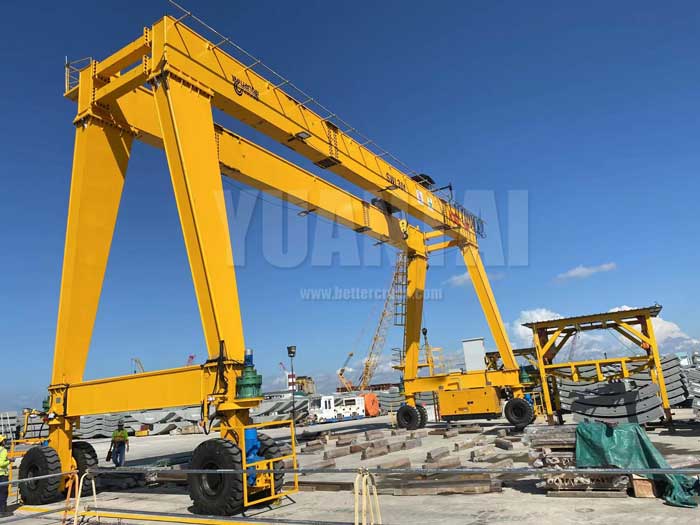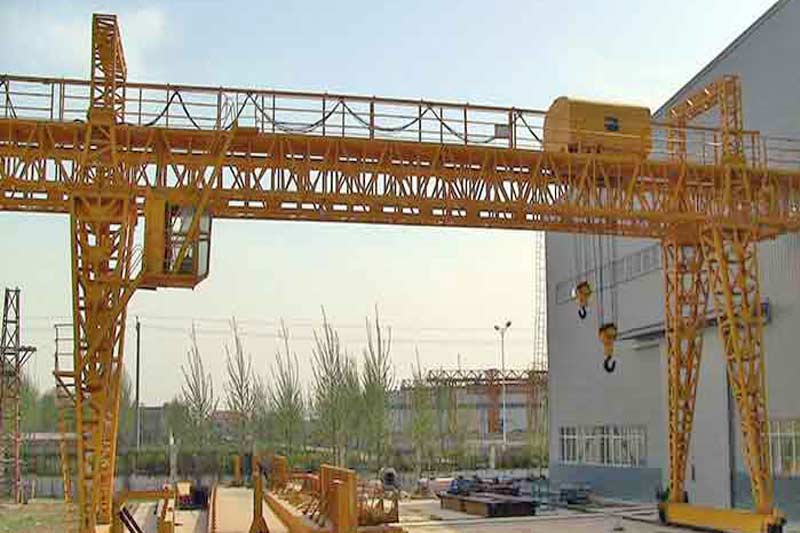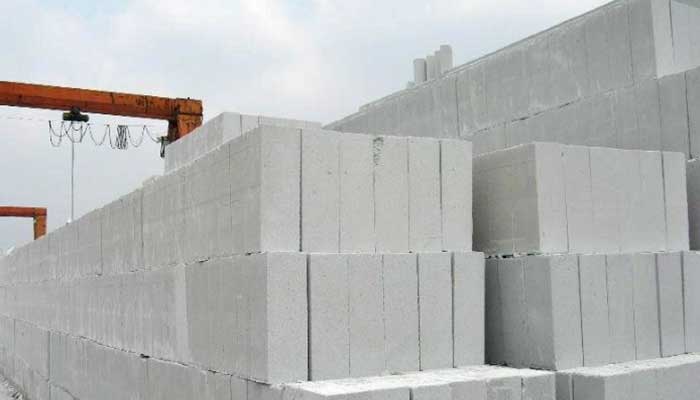Gantry Crane for Concrete Plant for Concrete Block Handling
Concrete block production demands a delicate ballet of precision and efficiency. In the realm of handling these fundamental building blocks, the role of gantry cranes stands out as a cornerstone in the seamless orchestration of processes. In this exploration, we delve into the significance of gantry cranes in concrete block production, providing a comprehensive overview of their varied applications and emphasizing the paramount focus on efficiency and precision.
Gantry cranes have become indispensable assets in the concrete block manufacturing landscape. Their robust design and versatile functionality make them ideal companions in the journey from raw materials to the final palletized blocks. These cranes, with their elevated structure and horizontal traverse, bring a unique set of capabilities that significantly impact the efficiency, safety, and overall productivity of concrete block plants.
Gantry cranes excel in the lifting and movement of heavy loads, making them well suited for the varied weights of concrete blocks. Whether handling hollow blocks, solid blocks, or intricate interlocking blocks, gantry cranes offer the strength and precision required for optimal manufacturing outcomes.
Overview of the Varied Applications in Block Formation
The applications of gantry cranes in concrete block production are as diverse as the blocks themselves. From the initial stages of block molding to the strategic handling of blocks within the plant and the organized palletizing of finished products, gantry cranes play pivotal roles at every turn.
Efficiency and precision are the dual pillars upon which successful concrete block production stands. Gantry cranes, with their ability to precisely position molds during the molding phase, contribute significantly to the creation of flawless blocks. The horizontal and vertical movement capabilities of these cranes ensure the efficient handling of blocks, reducing downtime and accelerating production timelines.
As we navigate through the concrete plant with gantry cranes at the helm, the focus remains unwavering – to achieve maximum efficiency without compromising precision. This balance not only streamlines the manufacturing process but also enhances the overall quality of the concrete blocks produced.
In the subsequent sections of this exploration, we will delve into the specific types of gantry cranes used, the diverse loads they handle, and real world applications that showcase their mastery in concrete block formation. Join us on this journey as we uncover the intricacies of gantry crane operations, exploring how they elevate concrete block production to new heights of efficiency and precision.
Types of Gantry Cranes for Concrete Block Handling
Gantry cranes stand as titans in the realm of concrete block production, offering a robust and versatile solution to the intricate demands of material handling. In this section, we delve into the definition and characteristics of gantry cranes, compare them with other crane types employed in concrete block production, and unravel the distinct advantages that make gantry cranes indispensable in the precise handling of concrete blocks.
Gantry cranes, also known as portal cranes, are characterized by their elevated structure supported by legs or columns. This design allows for horizontal movement along a rail or runway, providing a significant advantage in reaching different areas of the concrete plant. The key components of gantry cranes include the bridge (horizontal beam), legs or columns, end trucks, and the lifting mechanism, often equipped with hooks or other attachments.
In the concrete block handling, various types of gantry cranes are utilized to meet specific requirements and challenges. The choice of a gantry crane type depends on factors such as the size of the concrete blocks, the layout of the production facility, and the overall production process. Here are some common types of gantry cranes used for concrete block handling:
Full Gantry Crane:
Description: A full gantry crane, also known as a gantry bridge crane, features a horizontal bridge supported by two or more legs that run on wheels or along tracks. It spans the entire width of the working area, providing comprehensive coverage for material handling.
Application: Full gantry cranes are suitable for concrete block handling in large production facilities where the crane needs to cover a broad area for tasks such as mold positioning, transportation, and palletizing.
Rubber Tired Gantry Crane (RTG Crane):
Description: An RTG crane is mounted on rubber tires, providing mobility and flexibility in movement. These cranes are commonly used in outdoor environments, such as concrete block yards, and can move freely between different workstations.
Application: RTG cranes are suitable for handling concrete blocks in outdoor storage yards, providing the ability to cover large spaces without the need for fixed tracks.
Truss Girder Gantry Crane
Description: Truss girder gantry cranes are gantry cranes that travel on fixed rails. They are commonly used in concrete block production facilities with well defined production lines and fixed workstations.
Application:The truss girder gantry cranes are suitable for concrete block plants with a structured layout, allowing for precise and repeatable movements along fixed paths.
Characteristics Setting Gantry Cranes Apart in Concrete Block Handling:
Versatility:
One of the key characteristics that distinguish gantry cranes is their remarkable versatility. Gantry cranes are designed to cover a large working area, making them well-suited for concrete block plants of varying sizes. The structure of the crane, supported by legs or columns, allows it to traverse both horizontally and vertically, providing comprehensive coverage.
In concrete block production facilities, where the layout and size of the working area can vary, the versatility of gantry cranes ensures efficient material handling across different workstations. Whether the plant is compact or expansive, gantry cranes can adapt to the spatial requirements.
High Lifting Capacity:
Gantry cranes boast impressive lifting capacities, making them robust machines capable of handling heavy loads. The design of the crane, with its sturdy bridge and supporting legs or columns, provides the structural integrity needed to lift and transport the diverse weights of concrete blocks.
Concrete blocks come in various sizes and weights, especially in the production of solid, hollow, or interlocking blocks. Gantry cranes excel in lifting these heavy loads, facilitating the movement of raw materials, molds, and finished blocks with ease.
Precision Movements:
Precision is a hallmark of gantry crane operations. These cranes offer precise control over both horizontal and vertical movements. The bridge, end trucks, and lifting mechanism work in tandem, allowing for accurate positioning of the crane during critical phases of block production.
In concrete block handling, precision is paramount, especially during tasks such as mold positioning, transporting freshly molded blocks, and stacking finished blocks. Gantry cranes' ability to maneuver with accuracy contributes to the overall quality of block production.
Adaptability to Different Block Types:
Gantry cranes showcase adaptability to handle different types of concrete blocks, including hollow, solid, and interlocking blocks. Their versatility extends to accommodating blocks of varying shapes, sizes, and weights, contributing to a seamless production process.
Concrete block plants often produce a variety of block types based on project requirements. Gantry cranes, with their adaptability, ensure that the handling processes are optimized for the specific characteristics of each block type.
Comprehensive Coverage of Production Areas:
Gantry cranes are designed to provide comprehensive coverage of production areas, whether indoor or outdoor. The crane's ability to traverse the entire width and length of the working space ensures that no area is left untouched, contributing to an efficient and organized material handling workflow.
In large concrete block plants with multiple workstations, a gantry crane's ability to cover extensive areas allows for seamless transitions between different production phases, minimizing downtime and optimizing the overall production process.
In essence, the versatility, high lifting capacity, precision movements, adaptability, and comprehensive coverage make gantry cranes indispensable in the complex and dynamic environment of concrete block production. Their robust design and capabilities contribute significantly to the efficiency, safety, and success of concrete block plants.
Comparison with Other Crane Types in Concrete Block Production
While gantry cranes play a pivotal role in concrete block production, it's essential to compare them with other crane types commonly used in similar industrial settings:
Overhead Cranes:
Gantry Cranes: Gantry cranes have a more extensive range of movement due to their elevated structure, making them suitable for covering large production areas.
Overhead Cranes: Mounted to the ceiling, providing precision in localized lifting and movement.
Jib Cranes:
Gantry Cranes: Offer a broader coverage area and higher lifting capacity.
Jib Cranes: Limited to a fixed arc, suitable for localized lifting within a specific radius.
Mobile Cranes:
Gantry Cranes: Designed for fixed installations within concrete plants.
Mobile Cranes: Portable and suitable for outdoor construction sites, but may lack the precision required in confined indoor spaces.
Advantages of Gantry Cranes in Handling Concrete Blocks
The advantages of employing gantry cranes in concrete block production are multi faceted, contributing to the overall efficiency and effectiveness of the manufacturing process:
- Versatility in Movement: Gantry cranes' ability to traverse both horizontally and vertically ensures they can reach various workstations, optimizing the handling of concrete blocks.
- High Lifting Capacity: With their robust design, gantry cranes excel in lifting heavy concrete blocks, accommodating the diverse weights of hollow, solid, and interlocking blocks.
- Precise Positioning: Gantry cranes offer precise control, allowing for accurate positioning of molds during the molding phase and ensuring the efficient movement of blocks within the plant.
The elevated structure of gantry cranes allows them to cover expansive production areas, providing comprehensive material handling capabilities.
As we continue our exploration, the focus shifts to the heart of concrete block production – the diverse loads handled by gantry cranes, including hollow blocks, solid blocks, and interlocking blocks. Join us in the next section as we unravel the intricacies of handling these distinct block types and showcase the prowess of gantry cranes in mastering concrete block formation.
Typical Loads: Concrete Blocks (Hollow, Solid, Interlocking)
Gantry cranes in concrete block production are entrusted with the precise handling of various block types, each with its distinct characteristics and requirements. In this section, we delve into the description of different concrete block types – hollow, solid, and interlocking. We explore the varied weights and sizes of these blocks and emphasize the critical role played by gantry cranes in efficiently handling the diverse spectrum of concrete block types.
Description of Different Concrete Block Types
Hollow Blocks:
Characteristics: Hollow blocks are characterized by voids or empty spaces within their structure, making them lighter in weight compared to solid blocks.
Applications: Commonly used in construction for their lighter weight, providing insulation and reducing overall structural load.
Solid Blocks:
Characteristics: Solid blocks are dense, with no voids or holes in their structure, resulting in a heavier and more robust block.
Applications: Preferred for load bearing applications in construction due to their strength and durability.
Interlocking Blocks:
Characteristics: Interlocking blocks have unique designs that allow them to fit together like puzzle pieces, creating a strong and stable structure without the need for mortar.
Applications: Widely used in various construction projects for their ease of assembly and ability to create sturdy walls without the use of traditional mortar.
Varied Weights and Sizes of Concrete Blocks
Concrete blocks come in a range of weights and sizes, adding complexity to the handling process within a concrete plant. The weights can vary based on factors such as block type, dimensions, and density of the concrete mix. Gantry cranes, with their high lifting capacity, are designed to accommodate this variability.
- Hollow Blocks:Weight Range: Typically lighter compared to solid blocks, with weights ranging from a few pounds to several dozen pounds depending on size.
- Solid Blocks:Weight Range: Heavier than hollow blocks, with weights ranging from several dozen pounds to over a hundred pounds, depending on the block's size and density.
- Interlocking Blocks:Weight Range: Similar to solid blocks, the weight of interlocking blocks varies based on size and design, ranging from moderate to heavy.
Importance of Gantry Cranes in Handling the Diversity of Block Types
The handling of diverse concrete block types requires precision, adaptability, and strength – qualities that gantry cranes bring to the forefront in concrete block plants.
- Adaptability to Varying Weights:Gantry cranes, with their high lifting capacity, can seamlessly adapt to the different weights of hollow, solid, and interlocking blocks, ensuring efficient and safe handling.
- Precision in Placement:The precise control offered by gantry cranes is crucial when placing blocks during the molding phase or when transporting them within the plant. This precision minimizes the risk of damage and contributes to the overall quality of the blocks.
- Efficient Handling Workflows:Gantry cranes contribute to the creation of efficient workflows by accommodating the diversity of block types. Whether it's the lighter hollow blocks or the heavier solid and interlocking blocks, gantry cranes ensure a smooth and streamlined handling process.
As we navigate through the intricacies of concrete block handling, the adaptability and strength of gantry cranes emerge as key factors in achieving operational excellence. In the upcoming section, we explore the applications of gantry cranes in block molding, handling, and palletizing, shedding light on their pivotal role in shaping the concrete block production landscape. Join us as we uncover the mastery of gantry cranes in the heart of the concrete plant.
Crane Applications: Block Molding, Handling, and Palletizing
In the intricate dance of concrete block production, gantry cranes take center stage, orchestrating key processes with precision and efficiency. This section delves into the diverse applications of gantry cranes, showcasing their mastery in block molding, handling, and palletizing within a concrete plant.
Block Molding Processes and Gantry Crane Precision
- Precise Placement of Block Molds:Gantry Crane Role: Gantry cranes play a pivotal role in the molding phase by precisely placing molds in optimal positions. The ability to move horizontally and vertically ensures accurate alignment of molds, contributing to the creation of flawless concrete blocks.
- Importance: Precision in mold placement is crucial for the overall quality of concrete blocks, and gantry cranes provide the necessary control to achieve exact positioning.
- Efficient Handling During the Molding Phase:Gantry Crane Functions: Once molds are in place, gantry cranes facilitate the efficient handling of raw materials during the molding process. The crane's capability to lift and transport materials with precision contributes to a streamlined and productive molding phase.
Advantages: Gantry cranes minimize manual handling, reduce the risk of errors, and enhance the overall efficiency of the block molding process.
Strategic Handling of Concrete Blocks within the Plant
Safe Transportation of Blocks to Different Workstations:Gantry Crane Movements: Gantry cranes navigate through the concrete plant, transporting freshly molded blocks to different workstations with a focus on safety. The cranes' precise control and adaptability to varying block weights ensure secure transportation.
Safety Measures: Gantry cranes are equipped with safety features such as collision avoidance systems and load monitoring, ensuring the protection of both the equipment and personnel.
Minimizing Downtime and Optimizing Handling Processes:Workflow Efficiency: Gantry cranes contribute to minimizing downtime by efficiently handling blocks between different phases of production. Quick and precise movements help optimize the handling processes, reducing waiting times and enhancing overall plant productivity.
Adaptability: The adaptability of gantry cranes to varying block sizes and weights allows for flexibility in handling workflows, accommodating changes in production requirements.
Palletizing Operations and Gantry Crane Capabilities
- Organized Pallet Stacking of Finished Blocks:Gantry Crane Precision: Gantry cranes excel in the organized stacking of finished blocks onto pallets. The precise control over lifting and placement ensures stable and neatly stacked pallets, ready for further processing or transportation.
- Quality Assurance: The organized pallet stacking facilitated by gantry cranes contributes to the prevention of damage to finished blocks, ensuring the final product meets quality standards.
- Adaptability to Various Pallet Sizes and Configurations:Gantry Crane Flexibility: Gantry cranes showcase their adaptability by accommodating various pallet sizes and configurations. This flexibility is crucial in meeting diverse project requirements and allows for efficient utilization of space within the plant.
Efficient Space Management: The ability to handle different pallet sizes ensures optimal space management, contributing to an organized and well structured production area.
As we witness the precision and adaptability of gantry cranes in molding, handling, and palletizing concrete blocks, their mastery in orchestrating these critical processes becomes evident. In the upcoming section, we explore real world applications and case studies that highlight the success stories of gantry cranes in concrete block plants. Join us as we unveil concrete examples of how these cranes elevate efficiency and productivity in the intricate world of block production.
Innovations in Gantry Crane Technology for Concrete Block Production
As the construction industry evolves, so does the technology that powers it. In this section, we explore the latest innovations in gantry crane technology specifically tailored for concrete block production. From advancements in crane controls for precision handling to automation features that enhance operational efficiency, and environmental and safety innovations that redefine industry standards – gantry cranes are at the forefront of transformative technologies.
Advancements in Crane Controls for Precision Handling
- Digital Control Systems:Innovation: Gantry cranes are embracing advanced digital control systems that provide operators with enhanced precision and real time monitoring capabilities. These systems allow for precise positioning during critical phases such as block molding, ensuring unparalleled accuracy.
- Integration of IoT (Internet of Things):Innovation: Gantry cranes equipped with IoT capabilities offer connectivity and data exchange between the crane and other plant systems. This integration enhances overall visibility into crane operations, enabling predictive maintenance and optimizing performance.
- Remote Operation and Monitoring:Innovation: Remote operation features enable crane operators to control and monitor gantry cranes from a centralized location. This not only improves operator safety but also allows for more efficient handling of concrete blocks through centralized coordination.
Automation Features Enhancing Operational Efficiency
- Automated Load Positioning:Innovation: Advanced gantry cranes now feature automated load positioning, reducing the need for manual adjustments. This innovation streamlines the handling of different block types, ensuring optimal placement with minimal operator intervention.
- Dynamic Load Sensing:Innovation: Gantry cranes with dynamic load sensing capabilities can adjust their lifting capacity in real time based on the weight of the load. This ensures optimal energy usage and prevents unnecessary strain on the crane structure.
- Collision Avoidance Systems:Innovation: Integrated collision avoidance systems use sensors and advanced algorithms to detect potential collisions within the crane's operational space. This feature enhances safety by preventing accidents and minimizing the risk of equipment damage.
Environmental and Safety Innovations in Gantry Cranes
- Energy Efficient Design:Innovation: Gantry cranes are adopting energy efficient design principles, including regenerative braking systems and variable frequency drives. These features not only reduce energy consumption but also contribute to a more sustainable and environmentally friendly operation.
- Automated Safety Protocols:Innovation: Modern gantry cranes come equipped with automated safety protocols that can detect abnormal conditions and trigger emergency responses. These protocols enhance overall plant safety and protect both personnel and equipment.
- Environmentally Friendly Materials:Innovation: Manufacturers are exploring the use of environmentally friendly materials in gantry crane construction. The incorporation of sustainable materials aligns with the industry's growing emphasis on eco friendly practices.
As we witness these innovations in gantry crane technology, it's evident that these machines are not merely tools but integral components of a smart and efficient concrete block production ecosystem. The advancements discussed in this section mark a new era in crane technology, where precision, automation, and sustainability converge to shape the future of material handling in the construction industry.
In the final section, we bring our exploration to a close with a comprehensive conclusion that recaps the mastery of gantry cranes in concrete block handling, emphasizing their enduring impact on the efficiency and productivity of concrete plants. Join us as we reflect on the journey through the intricacies of gantry crane technology and its role in shaping the future of construction.
Wrap it up,
Gantry cranes have proven themselves to be indispensable assets in the realm of concrete block formation. Their elevated structures, versatile movements, and high lifting capacities have played a crucial role in molding, handling, and palletizing diverse block types. From the precise placement of molds to the efficient transportation of freshly molded blocks within the plant, gantry cranes have showcased their mastery at every turn. The adaptability to various weights and sizes, coupled with their ability to stack finished blocks in an organized manner, underscores the comprehensive role these cranes play in the production process.
In shaping modern concrete block production, gantry cranes have emerged as catalysts for efficiency, productivity, and safety. Their role extends beyond mere material handling; they are integral components in the optimization of workflows, reduction of downtime, and the creation of a safer working environment. Gantry cranes have become synonymous with precision, ensuring the creation of high quality blocks while contributing to the overall success of concrete block plants.




